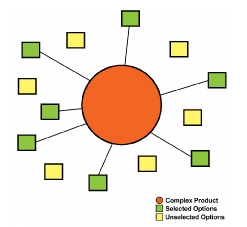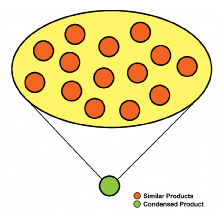|
Red Door Product Condenser
Is Industry’s Most Effective Tool For Selling Complex
Products On The Internet. |
| Red Door is a proven leader in helping companies sell complex
products on the internet. We allow distributors to simply
the selection process of products with complex and confusing
variations. |
|
What
are Complex Products?
Frustrated by the success of early E-Commerce sites were
those companies trying to sell products that didn't quite
fit into the straightforward pick-and-pay experience, in
which certain product characteristics weren't easily accommodated
by the software available at the time. So-called complex
products were challenging to sell because, well, they were
complex. Window blinds, industrial mats, custom-cut boxes
and made-to-order cable are just a few examples of products
that are complex and more difficult to sell than familiar
consumer-aimed products. Although it's natural to define
a complex product as one having product variations such
as size or color, it isn't just product variations that
make a product complex. In the early days, online merchants
quickly developed ways to sell consumer products that had
variations, so that a consumer could select the correct
size shoe, or the desired size and color shirt. But merchants
in the industrial sector found it much more challenging
because of the complex nature of not just the product variations,
but the underlying pricing models.
Unable to make effective use of off-the-shelf E-Commerce
solutions, many merchants selling complex products developed
their own in-house solutions, some with great success.
And innovative tools continue to be developed by forward-thinking
merchants who want to find better ways to sell complex
products. Now that the market for simple products has been
fully developed, the best growth opportunities for selling
online may well lie in the developing world of complex
products. Companies that can figure out how to effectively
sell complex products can gain a significant market edge
over competitors. |
 |
The differentiation between simple and complex products
is somewhat fuzzy, and there are several competing definitions
for what makes a product complex. Generally speaking, however,
a simple product is one that typically has 1) few variations
and 2) simple pricing. Examples include books, shoes, hats,
DVD's and the majority of consumer products. Complex products
are defined by 1) many variations and 2) complex pricing.
In the industrial marketplace, it is common for one type
of product to have hundreds of slight variations, and for
merchants to offer volume pricing. An ordinary bolt, for
example, may have variations in diameter, length, head
type, thread type, metal type, etc. The same bolt may have
four columns of volume pricing, offering preferential pricing
for customers who order in large quantities. Furthermore,
complex products often have pricing that is calculated
per bulk measure rather than per piece, as is the case
for cable sold by the linear foot, or steel sheet sold
by the square meter.
These types of variation and pricing complexities make
it difficult for merchants, especially smallto- mid-sized
merchants, to effectively sell these types of products
online.
There are two classes of tools that have emerged independently
among online merchants, both of which have broad applications
in the sale of complex products. Often confused with one
another, product configurators and product condensers both
simplify the presentation and selection of complex products,
but in different ways. |
Configurators
| |
Product Configurators |
|
| |
What are Product
Configurators?
A product configurator allows a customer to select options
for a product in a way that's intuitive, the end result
being a personalized product that can then be added to
a shopping cart and purchased. Configurators are used when
there are so many options associated with a product that:
1) standard E-Commerce solutions cannot be easily applied
and 2) it would be fruitless to treat each unique combination
of options as a separate SKU. Also, configurators allow
merchants to make the options interdependent, so that the
selection of one option determines the allowable selection
of other options.
One of the earliest configurators was Dell's E-Commerce
site which allowed customers to select desired options
and, in effect, build their own computer online. Because
the selection of one piece of hardware might preclude the
selection of another, the configurator needed to recognize
the relationship between the various options.
Configurators allow merchants to offer highly customized
products in a way that cannot be accomplished by off-the-shelf
E-Commerce software. In fact, merchants often build configurators
for a single type product, specifically tailored for the
characteristics of that product.
Configurators for
Product Discovery
Some merchants use configurators as product navigators,
fulfilling the role of an offline sales consultant in which
the customer specifies general requirements, and a list
of products meeting those requirements is presented. A
customer using a configurator to find a suitable type of
industrial hose, for example, could specify certain characteristics
such as diameter, operating environment and application;
the configurator would then present the full range of perhaps
a dozen or so suitable products based upon the configurator
entries.
Configurators for
Product Quotation
In more recent applications, configurators are used as
part of online quotation systems, in which a customer configures
a product with the desired options, and submits it to the
merchant as a request for quote. The merchant is then able
to build a quote on the configured item and send it to
the customer via email. |
|
|
| |
|
|
Condensers
| |
Product Condensers |
|
| |
What are Product
Condensers?
Product condensers are different than configurators in
that they provide customers with a convenient means to
select from a large number of related products. As mentioned
previously, many products in the industrial marketplace
have slightly different characteristics from one another,
but are sold under separate SKU's. Typically, online merchants
will list all of the SKU's in large tables, forcing the
customer to scan each table to locate a particular product.
A product condenser takes all of these related products
and condenses them down into a single object, which is
then displayed for the customer. The customer then selects
the characteristics that they want, and after they have
finished, the product associated with those characteristics
is displayed, along with the correct SKU and pricing. From
the customer perspective, there is only a single product
- they select the desired variations and move through the
purchasing process. This is much more efficient than scanning
through dozens or even hundreds of rows of mind-numbingly
similar products.
Reducing the Clutter
The primary advantage of a product condenser is that it
significantly reduces the clutter on a web page, and
provides an intuitive interface for customers to choose
from a large number of products.
Take the case of a merchant selling various types of bolts,
for example. Their web site may list hundreds of different
styles of bolts, each of which also has slight variations
in diameter, head type, thread type, length, etc. In a
traditional paper-based catalog, each of the slight variations
would typically be listed as a separate row in a large
table. However, using a product condenser on a web page
allows all of the related SKU's to be 'squeezed' into a
single object that appears on the web page. In short, many
products are condensed into a single product. In order
to purchase the product, the customer is first directed
to select a diameter, which triggers the display of available
lengths. Selecting one of the lengths triggers the display
of available head types, and so on. When the customer has
selected all required variations, the product's 'Buy Now'
button becomes visible, making the product available for
purchase. Also, the specific SKU and pricing for the selected
variations is displayed. All of this occurs in real-time,
driven by embedded code within the web page itself. There
are no server requests, thus, no delays in the product
selection process
Unit Measures and
Interdependencies
Product condensers respect the interdependencies between
product variations, ensuring that the customer can't purchase
a combination of variations that isn't available. Also,
product condensers can handle more advanced situations
in which the product is sold by units of measure such as
by linear foot or by square meter. At the appropriate stage
in the selection process, the customer is prompted to enter
in a measure, which is validated in real-time for adherence
to allowable minimum, maximum and incremental values. Thus,
the merchant could sell cable by the foot, specifying a
minimum length of 5 feet, a maximum length of 250 feet,
and lengths in increments of 2 feet.
In the marketplace for E-Commerce tools, the development
of product configurators is somewhat ahead of product condensers,
and there continues to be some overlap in how each is best
applied in actual practice. When faced with the need to
simplify the presentation of complex products, eBusiness
managers should consider whether they are dealing with
1) a single product with lots of options or 2) many products
that are highly similar. A product configurator is best
applied to a single product with many options, while a
product condenser is best applied to a group of highly
related products. |
|
|
| |
|
|
| |
Product Configurator |
|
| |
 |
Figure 1 - Product
Configurator
A complex product with many available options can
be more efficiently sold using a product configurator.
This allows customers to select options using an
intuitive interface, which automatically prevents
incompatible options from being simultaneously selected.
The configured product can then be purchased using
a conventional E-Commerce shopping cart system. |
|
|
| |
|
|
| |
Product Condenser |
|
| |
 |
Figure 2
- Product Condenser
When there are many products that are substantially
similar, a product condenser is an effective method
of simplifying the buying process for customers.
Instead of browsing through dozens or hundreds of
rows of products with only slight variations from
one another, a product condenser provides an intuitive
interface for selecting variations, arriving at a
single product. The product can then be purchased
using a conventional E-Commerce shopping cart system. |
|
|
| |
|
|
|
|
|